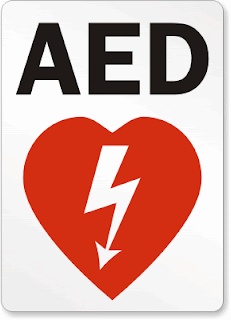In 2008, Congress designated the first week of June for observation of
National CPR / AED Awareness Week, with the goal of encouraging all states, cities and towns to establish organized programs which provide CPR (
Cardio
Pulmonary
Resuscitation) and AED (
Automated
External
Defibrillators) training to the public.
People are being offered opportunities to learn how to save a life threatened by
Sudden
Cardiac
Arrest (SCA). The
American Heart Association recommends that laypersons should learn “
Hands Only” or continuous chest compression CPR. Learn to save a life. You would want someone to do the same for you.
People are also urged to learn how to use
Automated
External
Defibrillators (AEDs), which are safety devices that are becoming more available in public locations so that they can be used
immediately if someone collapses in SCA. AEDs can restore a normal heartbeat, as long as they are used quickly and effectively.
Many facilities have also recognized the need for
Automated
External
Defibulators, or AED's. These can save live of both staff and patrons in your performing arts facility. You should have one in the lobby
and backstage between the shop(s) and the stage.
Units should be in plain sight and readily accessible. Employ clear signage to assist locating the units.
Photoluminescent signage is recommended.
Backstage, stress, falls, and/or electrical shock can be common causes of SCA, while in the front of house, it may be due to the sudden excitement in the show, patrons over-exerting themselves climbing stairs, or rushing to get to the show on-time. Whatever the cause,
having personnel and equipment available immediately is key to a good outcome.
Call for Help. Don't forget that hardline (wired) phones are always best to call for emergency services, as cellular phones don't automatically track-back to the facility address. Also remember to clearly post the facility address adjacent to the telephone.
How are you going to pay for an AED? Local, state, and federal governments sometimes makes funding available for AEDs in the form of grants. Though finding these grants for your AED program can require an investment of both time of energy, the effort may be worthwhile.
Government funding: For federal funding options look at the Catalog of Federal Domestic Assistance at
http://www.cfda.gov/
Private Funding: For funding from private organizations look at the Foundation Center at
http://www.foundationcenter.org/
Other helpful information can be found at the
Proposal Development: A written proposal is almost always required to apply for a grant. For assistance in writing an effective proposal, you can find excellent instructions and examples at
http://www.minerandassociates.com/
A grant project can take weeks or months to complete. If your needs are more immediate, look toward civic groups such as your local PTA, Lions Clubs, Moose Lodges, Elks Clubs, Kiwanis, Rotary Clubs, and Masonic Temples. If your project is aimed at the well-being of children, a local Optimist Club could be a source.
Of course, it can't hurt to look to your own theatres' patrons and supporters for financial help. Having an AED on-site can save their lives, too!
Other Grant Resources:
Sudden Cardiac Arrest Foundation -
www.sca-aware.org/finding-funding
Zoll Medical Devices -
www.zoll.com/medical-products/automated-external-defibrillators/aed-grant-information
AED Grant.Com -
http://www.aedgrant.com/





